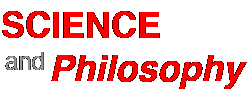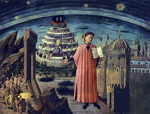Reading on: Dante's vision of an ordered universe
Dante
Alighieri (1265-1321) “The Banquet” from
Van Baumer, Franklin Le, ed Main Currents of Western Thought, Yale University Press, New Haven 1978 [Abridged–1200 words] [abstract–
290 words]— the medieval worldview
(Translated by Katherine Hillard; Kegan Paul, Trench & Co. London
1889)
Ptolemy afterwards, perceiving that the eighth sphere had more than one motion (seeing that its revolution varied from the true circuit, which turns only from east to west), and constrained by the principles of philosophy (which necessarily demanded a perfectly simple Primum Mobile), supposed another heaven to exist beyond that of the Fixed Stars, which made this revolution from east to west. This revolution, I say, was completed in about twenty-four hours, that is, in twenty-three hours and fourteen parts of the fifteen of another [hour], roughly calculated. So that according to him, and according to that which is received in astrology and in philosophy since these movements were seen, the movable heavens are nine; and their position is plain and determined, as the art of perspective, arithmetic, and geometry proves to our senses and our reason, and of which our senses have other testimony....
And the order of position [of the heavens] is this, that the first one enumerated is that where the Moon is; the second that where Mercury is; the third that where Venus is; the fourth that where the Sun is; the fifth that where Mars is; the sixth that where Jupiter is; the seventh that where Saturn is; the eighth that where the Fixed Stars are; the ninth is that which is not perceptible to sense (except by the motion spoken of above), and which is called by many the Crystalline, that is, the diaphanous, or wholly transparent.
However, beyond all these, the Catholics place the Empyrean Heaven, which is as much as to say the Heaven of Flame, or Luminous Heaven; and they hold it to be immovable, because it has within itself, in every part, that which its matter demands. And this is the reason that the Primum Mobile moves with immense velocity; because the fervent longing of all its parts to be united to those of this [tenth and] most divine and quiet heaven, makes it revolve with so much desire that its velocity is almost incomprehensible.
And this quiet and peaceful heaven is the abode of that Supreme Deity who alone doth perfectly behold Himself. This is the abode of the beatified spirits, according to the holy Church, who cannot lie; and Aristotle also seems to think so, if rightly understood, in the first of [his book] The Heavens and Earth. This is the supreme edifice of the universe, in which all the world is included, and beyond which is nothing; and it is not in space, but was formed solely in the Primal Mind, which the Greeks called Protonoe. This is that magnificence of which the Psalmist spake, when he says to God, “Thy magnificence is exalted above the heavens.” And thus, summing up what has been here discussed, it seems that there are ten heavens, of which that of Venus is the third; and this will be spoken of in the place where I intend to explain it...
Since it has been demonstrated in the preceding chapter what this third heaven is, and how it is ordered within itself, it remains to show who they are who move it. Therefore be it known, in the first place, that these are Substances separate from matter, that is, Intelligences, whom the common people call Angels. And of these creatures, as of the heavens, different [writers] have held different opinions, although the truth is now known.
There were certain philosophers, among whom seems to have been Aristotle in his Metaphysics who believed that there were only as many of these [Intelligences] as there were circulations of the heavens, and no more; saying that other than these would exist eternally in vain, without effectuality; which were impossible, seeing that their being consists in their effectuality.
There were others like Plato, a most excellent man, who maintained that there are not only as many Intelligences as there are motions of the heavens, but also as many as there are kinds of things; such as one kind for all men, another for gold, another for treasures, and so on; and they say that as the Intelligences are the generators of these [motions], each of its own, so these other [Intelligences] are the generators of all other things, and the exemplars each of their own kind; and Plato calls them Ideas, which is as much as to say forms, and universal natures. The heathen called them gods and goddesses (although they had not so philosophical an understanding of them as Plato had), and adored their images, and built to them great temples—as to Juno, whom they called the goddess of power; to Vulcan, whom they called the god of fire; to Pallas, or Minerva, whom they called the goddess of wisdom; and to Ceres, whom they called the goddess of grain…
Again, all this heaven moves and revolves with the epicycle from east to west, once in every day; which movement, whether it be caused by some Intelligence, or by the rush of the Primum Mobile, God knows, for to me it seems presumptuous to judge. These motive Powers guide by their thought alone the revolutions over which each one presides. The most noble form of the heaven, having within itself this principle of passivity, revolves at the touch of the motive force willing it so to move, and I say touch, not in a corporeal sense, of the power that is brought to bear on it…
Here we must reflect upon a comparison between the order of the heavens and that of the sciences. For, as has been said above, the seven heavens nearest to us are those of the planets; then there are two heavens above these, movable, and one over all the rest, motionless. To the first seven correspond the seven sciences of Grammar, Dialectics, Rhetoric, Arithmetic, Music, Geometry, and Astrology. To the eighth sphere, that is, to the Starry Heaven, correspond Natural Science, called Physics, and the first of sciences called Metaphysics; to the ninth sphere corresponds Moral Science; and to the Quiet Heaven corresponds Divine Science, which is called Theology...
… in the second [part] Of Heaven and Earth, by that glorious Philosopher to whom Nature has most completely revealed her secrets [Aristotle]; and by him it is there proved that this world, that is, our earth, stands still and fixed to all eternity. And the reasons Aristotle gives to controvert these opinions, and to affirm the truth, it is not my intention to relate here; because it is quite enough for those to whom I speak, to know on his great authority that this earth is immovable, and does not revolve, and that, with the sea, it is the centre of the heavens.


